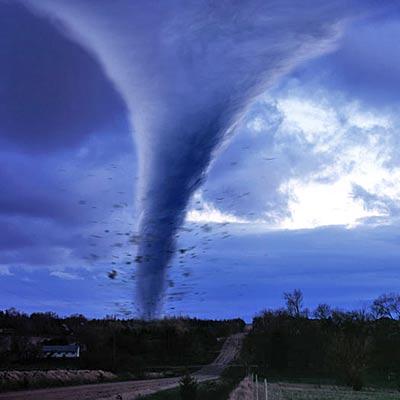DISASTERS
Чтобы узнать все о стихийных бедствиях/natural disasters, ПЕРЕЙДИТЕ ПО ССЫЛКЕ:
Researchers have been studying disasters for more than a century, and for more than forty years disaster research. The studies reflect a common opinion when they argue that all disasters can be seen as being human-made, their reasoning being that human actions before the strike of the hazard can prevent it developing into a disaster. All disasters are hence the result of human failure to introduce appropriate disaster management measures. Hazards are routinely divided into natural or human-made, although complex disasters, where there is no single root cause, are more common in developing countries. A specific disaster may spawn a secondary disaster that increases the impact. A classic example is an earthquake that causes a tsunami, resulting in coastal flooding.
A natural hazard is a natural process or phenomenon that may cause loss of life, injury or other health impacts, property damage, loss of livelihoods and services, social and economic disruption, or environmental damage.
Various phenomena like earthquakes, landslides, volcanic eruptions, floods, hurricanes, tornadoes, blizzards, tsunamis, and cyclones are all natural hazards that kill thousands of people and destroy billions of dollars of habitat and property each year. However, the rapid growth of the world's population and its increased concentration often in hazardous environments has escalated both the frequency and severity of disasters. With the tropical climate and unstable land forms, coupled with deforestation, unplanned growth proliferation, non-engineered constructions which make the disaster-prone areas more vulnerable, tardy communication, and poor or no budgetary allocation for disaster prevention, developing countries suffer more or less chronically from natural disasters. Asia tops the list of casualties caused by natural hazards.
Human-instigated disasters are the consequence of technological hazards. Examples include stampedes, fires, transport accidents, industrial accidents, oil spills and nuclear explosions/radiation. War and deliberate attacks may also be put in this category. As with natural hazards, man-made hazards are events that have not happened—for instance, terrorism. Man-made disasters are examples of specific cases where man-made hazards have become reality in an event.
There are some examples of nayural disasters:
Researchers have been studying disasters for more than a century, and for more than forty years disaster research. The studies reflect a common opinion when they argue that all disasters can be seen as being human-made, their reasoning being that human actions before the strike of the hazard can prevent it developing into a disaster. All disasters are hence the result of human failure to introduce appropriate disaster management measures. Hazards are routinely divided into natural or human-made, although complex disasters, where there is no single root cause, are more common in developing countries. A specific disaster may spawn a secondary disaster that increases the impact. A classic example is an earthquake that causes a tsunami, resulting in coastal flooding.
A natural hazard is a natural process or phenomenon that may cause loss of life, injury or other health impacts, property damage, loss of livelihoods and services, social and economic disruption, or environmental damage.
Various phenomena like earthquakes, landslides, volcanic eruptions, floods, hurricanes, tornadoes, blizzards, tsunamis, and cyclones are all natural hazards that kill thousands of people and destroy billions of dollars of habitat and property each year. However, the rapid growth of the world's population and its increased concentration often in hazardous environments has escalated both the frequency and severity of disasters. With the tropical climate and unstable land forms, coupled with deforestation, unplanned growth proliferation, non-engineered constructions which make the disaster-prone areas more vulnerable, tardy communication, and poor or no budgetary allocation for disaster prevention, developing countries suffer more or less chronically from natural disasters. Asia tops the list of casualties caused by natural hazards.
Human-instigated disasters are the consequence of technological hazards. Examples include stampedes, fires, transport accidents, industrial accidents, oil spills and nuclear explosions/radiation. War and deliberate attacks may also be put in this category. As with natural hazards, man-made hazards are events that have not happened—for instance, terrorism. Man-made disasters are examples of specific cases where man-made hazards have become reality in an event.
There are some examples of nayural disasters:
TORNADO
A tornado is a violent, dangerous, rotating column of air that is in contact with both the surface of the earth and a cumulonimbus cloud or, in rare cases, the base of a cumulus cloud.
EARTHQUAKE:
An earthquake is the result of a sudden release of energy in the Earth's crust that creates seismic waves. At the Earth's surface, earthquakes manifest themselves by vibration, shaking and sometimes displacement of the ground. The vibrations may vary in magnitude. Earthquakes are caused mostly by slippage within geological faults, but also by other events such as volcanic activity, landslides, mine blasts, and nuclear tests.
Drought is a long period when there is no rain and people do not have enough water. The absence of rain causes fail of crops and death of livestock.
A flood is an overflow of water that submerges land. The EU Floods directive defines a flood as a temporary covering by water of land not normally covered by water.Flooding may result from the volume of water within a body of water, such as a river or lake, which overflows causing the result that some of the water escapes its usual boundaries.
Famine is a lack of food for a long time in a particular place. Drought could result in famine throughout the region.
Look the video and retell it:
TSUNAMI
Tsunami is a long high sea wave caused by an earthquake or other disturbance. It Is an extremely large wave caused by a violent movement of the earth under the sea
DROUGHT
Drought is a long period when there is no rain and people do not have enough water. The absence of rain causes fail of crops and death of livestock.
FLOODS
FAMINE
Famine is a lack of food for a long time in a particular place. Drought could result in famine throughout the region.
Look the video and retell it:






hello
ОтветитьУдалить